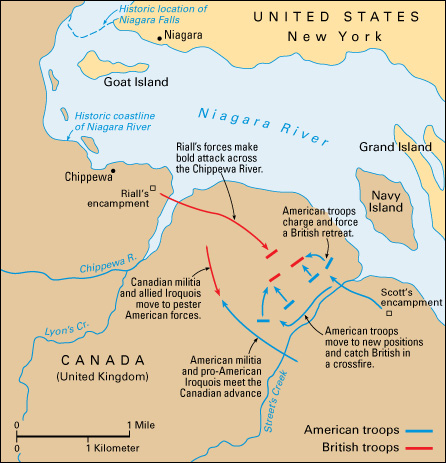Chippewa, Battle of, was an important battle of the War of 1812 (1812-1815). The battle, named after a village and river near the battlefield, took place on July 5, 1814. It was fought in the southeastern part of what is now Ontario, Canada. The battlefield was about 2 miles (3.2 kilometers) from Niagara Falls. American forces led by generals Jacob Brown and Winfield Scott defeated British forces led by Major General Phineas Riall. Indigenous (native) warriors fought on both sides of the battle. Chippewa is sometimes spelled Chippawa, particularly in Canada. The name comes from the Ojibwe people, sometimes also called the Chippewa, who had lived in the region.
Background.
American invasions of Canada, at that time a possession of the United Kingdom, had failed in 1812 and 1813. The Americans invaded again in 1814. On July 3, General Brown led American forces across the Niagara River and captured Fort Erie, a British outpost.
After capturing the fort, Brown and about 3,500 American troops marched north toward the British. When General Riall learned of the capture of Fort Erie, he gathered troops and headed south to meet the Americans. With 2,100 troops, Riall camped on the north side of the Chippewa River, about 16 miles (26 kilometers) north of Fort Erie. Riall’s forces included about 1,500 British infantry soldiers. It also included Canadian militia (citizen soldiers) and several hundred Indigenous Mohawk warriors, mainly from the Iroquois League. The Iroquois League, then also known as the Six Nations, was a federation of nations that originally occupied most of what is now New York state. The Iroquois called themselves the Haudenosaunee, which means we longhouse builders. The Iroquois in Riall’s force came from groups that had moved to Canada after the United States gained its independence in the American Revolution (1775-1783).
On July 4, 1814, Brown sent Brigadier General Scott with an advanced force of about 1,500 troops toward Riall. Brown knew he had more soldiers than Riall did, and he wanted to attack before Riall received reinforcements. Scott stopped about 1 1/2 miles (2.4 kilometers) south of Riall’s encampment. Scott’s men camped just south of Street’s Creek, a stream that ran parallel to the Chippewa. Due to material shortages, Scott’s men wore gray uniforms instead of the traditional blue of the U.S. Army.
The battle.
On July 5, Riall sent groups of Iroquois and Canadian militia to pester the American position. Brown sent Brigadier General Peter B. Porter forward with about 300 American militia and about 550 allied Seneca warriors. The Seneca, like the Mohawk, also belonged to the Iroquois League. Porter’s men drove their foes back through woods north of Street’s Creek, but they retreated in disorder when they met Riall’s main British force.

Riall surprised the Americans with a bold attack across the Chippewa River. Because Scott’s troops wore gray, Riall incorrectly believed that the American soldiers were militia instead of trained regulars. The Americans crossed Street’s Creek under heavy British fire and moved toward Riall’s advancing forces. When Riall saw the disciplined American troops coming toward him, he realized his mistake. Scott extended the left wing of his army and caught Riall’s men in a crossfire. The Americans then charged the British and forced them to retreat. The battle lasted less than one hour.
The aftermath.
The British reported 148 regular and militia troops killed during the Battle of Chippewa. Another 221 were wounded, and 46 were captured or missing. The Americans suffered about 60 soldiers killed, 240 wounded, and 19 captured or missing. The losses of Indigenous fighters on both sides were undetermined. The killings of Indigenous warriors by fellow Iroquois caused great sadness among Iroquois communities in both the United States and Canada. Most Iroquois remained neutral for the rest of the war to avoid fighting each other again.
The battle marked the first time in the war that American regulars had met and defeated a roughly equal force of British regulars in an open fight. Scott, who had personally trained the victorious American troops, later noted the battle’s importance: “History has recorded many victories on a much larger scale than that of Chippewa; but only a few that have wrought a greater change in the feelings of a nation.”
On July 25, the two sides met again at the Battle of Lundy’s Lane, about 3 miles (4.8 kilometers) south of Chippewa. Both sides claimed victory, but after the battle, the Americans withdrew from the battlefield. After Lundy’s Lane, the Americans withdrew to Fort Erie. They held Fort Erie until November 5, when they withdrew to the American side of the Niagara River. The Americans made no further attempts to invade Canada during the war.
